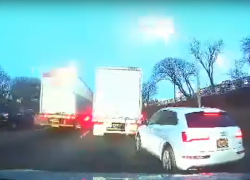— A Tesla Model X crash in New York has caused a lawsuit which alleges the Autopilot system failed and totaled the Model X while damaging two other vehicles.
Wai-Leung Chan says he was driving the Model X eastbound in the far-right lane of the Long Island Expressway on December 17, 2017, in what he describes as dense and slow traffic.
The Model X allegedly had the Traffic-Aware Cruise Control and Autosteer functions engaged with the following distance set at “3” and Chan alert at the wheel. The Model X was following a white tractor-trailer in heavy traffic when a white Audi began to merge in between the tractor-trailer and the Tesla.
The Model X at first decelerated as the merging Audi entered the lane between the tractor-trailer and the Tesla.
According to the lawsuit, the Model X decelerated because the tractor-trailer Chan had been following slowed for traffic, not because the Audi had started to enter into Chan’s lane of travel.
As the Audi was merging, the Tesla moved forward suddenly and accelerated on a collision course with the Audi.
"To Chan’s surprise, the Vehicle did not recognize that the Audi had merged into the lane of travel that the Vehicle occupied or that the Audi was even present at all. The Vehicle failed to react or warn Chan of the impending collision and failed to deploy its Automatic Emergency Braking." - Model X lawsuit
Chan says he had about one second to react and intervened as quickly as he could by steering to the left to avoid a collision with the Audi. As a result, the Model X collided with two other vehicles before coming to a stop. (Video below)
The lawsuit alleges the Tesla again failed to recognize a potential collision with the two adjacent vehicles and failed to engage the automatic emergency braking feature.
Tesla allegedly insists the Model X performed correctly and that Traffic-Aware Cruise Control and Autosteer “disengaged as designed” when the SUV decelerated below the systems’ minimum operating speed. In addition, Tesla argues the owner's manual reminds drivers to remain alert and never rely on Autopilot to steer or decelerate the vehicle.
Chan says Tesla has previously admitted that Autopilot may sometimes fail to "identify or appropriately respond to white obstacles and slow-moving vehicles." However, the lawsuit alleges Tesla has failed to take responsibility for the Model X crash.
The automaker also argues the owner's manual says the “Forward Collision Warning and Automatic Emergency Braking functions do not operate at speeds under 4 mph and 5 mph, respectively.” But Chan says the vehicle "does not adequately or timely warn the driver when Autopilot functions are disengaged or about to disengage."
According to court documents, Tesla doesn't warn customers how Autopilot can fail while driving in dense traffic because the system doesn't recognize other vehicles and hazards on the road.
"In fact, even in less complicated driving situations, Autopilot fails to recognize and warn drivers of traffic patterns that involve merging, such as where lane changes take place, traffic exits and enters the highway, and traffic merges as lanes consolidate." - Chan's lawsuit
Tesla's promotional materials should allegedly warn customers that Autopilot can seriously struggle in certain driving situations which involve routine driving scenarios.
The lawsuit also alleges Tesla intentionally builds its vehicles and programs its software to ignore slow-moving and stationary objects.
Tesla also allegedly tries to distance itself from potential liabilities by initially referring to the Model X operating software as being in a “beta-testing phase.”
But after Germany’s Federal Office for Motor Vehicles refused to approve Autopilot for use on German roads, Tesla allegedly said the word “beta” was not used in the standard sense of the word but "was used to make sure Tesla drivers do not get too comfortable with its autopilot system."
"Tesla misplaces responsibility in the hands of its drivers to safely conduct a takeover response and control a Tesla when the Autopilot malfunctions. When those drivers ultimately are unable to correct the Autopilot error, Tesla tries to lay the blame for accidents resulting from any of these situations at the feet of its customers." - Model X Autopilot lawsuit
The Tesla Model X crash lawsuit was filed in the U.S. District Court for the Southern District of New York: Jing Wang and Wai-Leung Chan, v. Tesla, Inc.
The plaintiffs are represented by Nelson Law, LLC, in New York.
Tesla Model X Crash Video

